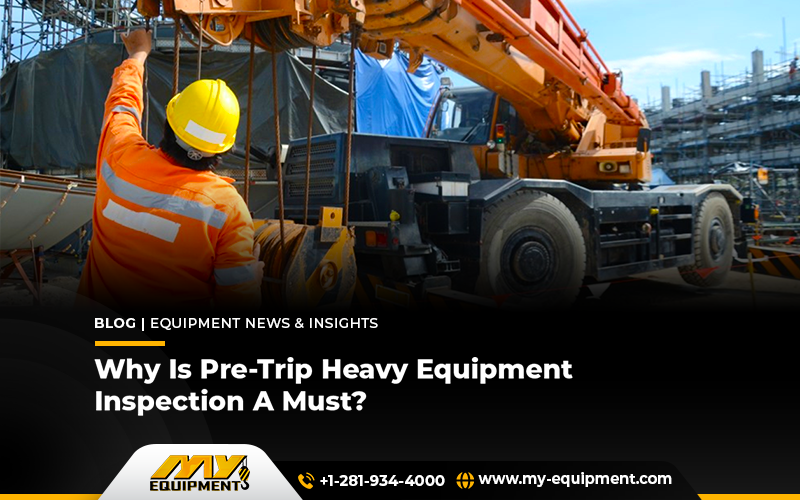As a heavy machinery operator, you must know the significance of pre-inspection of the equipment. Although some drivers do take the part of pre-inspection light before hitting the road. But it is necessary to inspect the heavy construction equipment before you take it on the road. As failure to accomplish a pre-inspection routine can result in surprise breakdowns and delayed deliveries.
Let us give you five main reasons why a pre-inspection regime will help your business operations.
Safety
As a heavy equipment driver prioritising your safety and the people around is too important to neglect. Imagine taking out a used wheel loader onsite with loose wirings or failed brakes.
To save yourself from such nightmares it is essential to spare 30 minutes in pre-inspecting the heavy machinery before running out. Driving a machinery without checking it prior makes you one step closer to an uncertain roadside incident.
Legal Compliance
If you drive heavy construction equipment in the U.S. you are already aware of the strict state policies regarding driving heavy-duty vehicles. You need to inspect and log prominent issues about the machinery so that you don’t get charged with a penalty for driving poorly-conditioned equipment.
As it’s always better to pre-inspect and resolve the issue beforehand, the officer finds it out and stops your vehicle from passing by.
Officers in the U.S. are strict enough to charge you with multiple fines that can firstly cost you financial loss as well as defame your business in the long run.
Operation Cycle
Driving a pre-inspected vehicle can keep you off-road, especially if the officer catches you driving troubled equipment. He will stop you from passing and charge you with fines that will directly delay your operation.
Also ignoring minor issues can turn into major problems. So you must resolve small issues at their earliest.
Moreover, driving heavy construction equipment that is not pre-inspected is like gyming with a shoulder injury.
Any underlying issue can make the vehicle prone to accidents resulting in damaging it to a greater extent while risking the driver’s life.
Finances
You may think that pre-inspecting equipment is becoming an additional expense as well as a time-consuming activity. And that you should better skip pre-inspecting the equipment.
But in reality, pre-inspecting heavy machinery highlights hidden issues, improves equipment’s performance and enhances your overall supply chain cycle.
Mitigating a small loss will cost you less money as compared to repairing or replacing damaged parts of the heavy machinery. If your machinery stops in between the delivery or construction operation.
The roadside repair will cost you 5x more than an average mechanic repair.
So the choice of investing in pre-inspection rather than post-damage is all yours now!
Liability
You can become liable for an accident if you drive heavy machinery that gets detected with a defect. Especially if there was no pre-inspection done before you took the vehicle onto the roads. Having said that, if you see any issue and it’s fixed keep a documentation history along with you as proof.
So in case you get caught in an accident no legal policy can go against you as you already have proof of driving defect-free heavy equipment.
How To Conduct A Pre-Trip Heavy Equipment Inspection Schedule?
As such there is no particular time to invest in a pre-inspection schedule but 30 minutes daily before taking the machinery onsite can save you from many mishappenings. The summary of a well-executed equipment inspection is as follows;
Engine and Front of Heavy Equipment
Begin with checking the essential heavy construction equipment fluids. It includes engine oil,
Winsheuild cleaning fluid, coolants and power steering lubricants. Then check the air or gas pressures of compressors, equipment tyres, water pumps and similar components.
Equipment Rear And Side
Checking the sides and rear of equipment includes checking the air hoses and similar outlets. Moreover, you can check the brakes and other suspension-based equipment parts.
Coupling Device
Coupling inspection includes inspecting the kingpin and fifth wheel. Here you need to inspect the pivot pin, skid plate, release arm and slide locking pin. It will ensure that all heavy construction equipment components are intact and functioning properly.
Cabin Check
Cabin check involves checking the seatbelts, room clutch, shifting distance and parking brake. Additionally, check the gauges, windshield operations, equipment lights and similar visibility features.
Brake Inspection
Driving heavy equipment without checking on the brakes can cost you a life. Therefore checking out all before you take the vehicle on the road is a must. Brakes include hydraulic brakes, air brakes and parking brakes.
Safety Equipment Inspection
The last and most important part of the preinspection of heavy equipment is checking the safety equipment. It includes checking the options for fire extinguishers, electrical fuses, spare parts availability and three safety triangles.
Takeaway
Managing heavy equipment is the duty of the fleet owner and more importantly the driver himself. Whether it’s used heavy equipment or a new piece, pre-inspecting it before taking it on the road should be a religious practice.
As per the above-mentioned factors, it is significant to inspect the equipment prior to driving it. Pre-inspection will help you drive while that is safe, intact and liability-free.
Moreover, following the step-by-step guide for pre-inspecting heavy equipment will help you get a high safety rating as a heavy equipment driver.


 1400 Broadfield Blvd, Houston, TX 77084,
USA.
1400 Broadfield Blvd, Houston, TX 77084,
USA. omer@my-equipment.com
omer@my-equipment.com